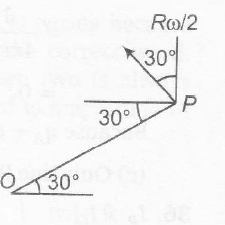Answer:
Option A,B
Explanation:

Velocity of point O is
$v_{0}=(3R\omega)\widehat{i}$
$V_{PO}$ is $\frac{R.\omega}{2}$ in the direction shown in the figure. In vector form
$v_{PO}=-\frac{R \omega}{2} \sin 30^{0}\widehat{i}+\frac{R\omega}{2}\cos 30^{0} \widehat{k}=-\frac{R\omega}{4}\widehat{i}+\frac{\sqrt{3}R\omega}{4}\widehat{i}$
bu $v_{PO}=v_{P}-v_{O}$
$\therefore$ $v_{p}=v_{po}+v_{o}$
$=\left(-\frac{R\omega}{4}\widehat{i}+\frac{\sqrt{3}R\omega}{4}\widehat{k}\right)+3R \omega \widehat{i}$
$=\frac{11}{4} R\omega \widehat{i}+\frac{\sqrt{3}}{4}R \omega \widehat{k}$